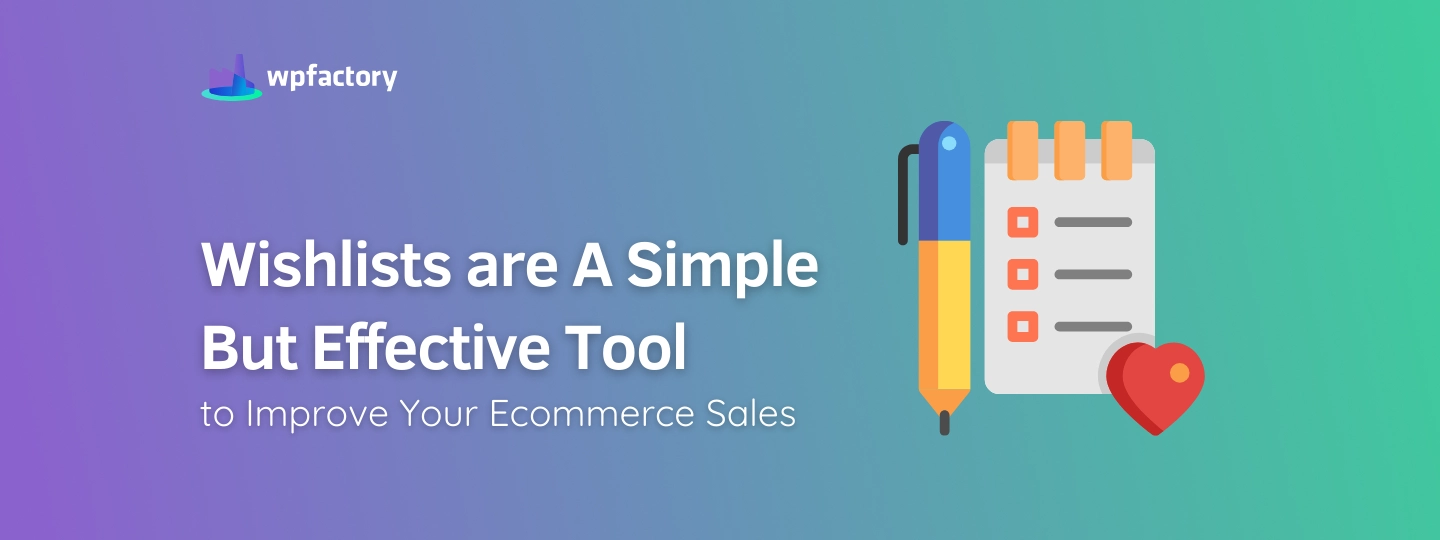Wishlists are A Simple But Effective Tool to Improve Your Ecommerce Sales
Running an E-commerce store is an art. Many people buy online because of convenience but convincing your store’s visitors to purchase from you and not from your competitors can be a daunting task. There are several tricks and techniques you can use to increase visitor conversion. In the last article, we looked at how you can use scarcity and urgency in your E-commerce store to boost conversions. Another great technique to increase engagement and purchases is to use wish lists.
What are Wishlists?
A wish list just as the name suggests is a collection of products that customers wish for or want to purchase. Wish lists allow customers to create a personal collection of products that they are interested in. They may not have the intent to purchase the product immediately and allowing them to save the product to purchase later. It saves users time when they come back to purchase the item, by allowing them to simply access it from the wish list rather than searching for it again. It also serves as a reminder that they were interested in those products.
Importance of Wishlists
A study conducted by Google shows that “44 percent want a wishlist where they can save items they’re interested in.” this is a clear indicator of the importance of having a wishlist in your E-commerce store.
Here are 7 ways in which wish lists help your business:
1. Improves Customer Shopping Experience
If customers like a product on your store but are unable to commit to purchasing at that very moment, a wish list is a great tool to allow them to save the product and purchase it later. If they don’t have the option of a wish list, it can sometimes be difficult to come back and search for the same product. Users accessing your store from mobile phones will particularly find this appealing, as it will save them a lot of time on a smaller screen.
2. Retain Leads
Getting visitors to come to your store is a mountainous task in itself. If customers like a product on your store and leave without purchasing it, the chance of them coming back to purchase the product is low. Wish lists can encourage users to sign up for an account. If they create an account on your store and add items to their wish list, you can easily send them reminders that they were interested in the product.
3. Deal with Out-of-Stock Items
Often customers can like a product that may be currently out of stock. Having customers add out-of-stock products to their wish lists can allow them to track the status of the products. You can easily notify them when the product is back in stock. You can replace the add to cart button for out-of-stock items with an add to wish list button. Once customers have added the products to their wish list you can simply notify them when items are back in stock.
4. Clear out Remaining Stock Faster
If customers have added products to their wish list you can easily judge the popularity of the product. Sometimes it can be difficult to clear the last few remaining items. You can easily notify customers who have added these products to their wish list that the items are low in stock. This can create scarcity and urgency thereby encouraging purchases and clearing stock faster.
5. Alert Customers About Offers
It takes a lot for a customer to actually commit to a purchase. Customers have various reasons for abandoning online purchases. You never know if they simply got distracted, did not have enough trust in your store or any other reason for them abandoning a purchase. Sometimes customers will add products to their wish list instead of purchasing. It might just be they need some time before they can purchase. To encourage purchases you can offer discounts to people who have products in their wish list. This can create the fear of missing out and easily convert visitors to paying customers. If the discount is for a limited time it can also create scarcity and urgency.
6. Judge Popularity of an Item
The 80/20 rule also applies to E-commerce stores, where 20% of your products will generate 80% of your sales. Knowing which items are popular and being added to wish lists can help you tailor marketing campaigns to promote the already popular items.
7. Attract More Visitors
If customers can share their wish lists on social networks, email, and messaging apps such as WhatsApp it becomes a great way of promotion. It’s an inexpensive way of advertising. It will also add to the confidence of new visitors as they will be coming to your store because of someone they know. It is always easier to sell to someone who has heard about you or your brand before than a first-time visitor to your store, who has never heard about your brand.
E-commerce Stores That Successfully Implement Wishlists:
There are numerous examples in the online world that utilize wishlists to boost their online sales.
Amazon, the giant E-commerce platform, allows users to create multiple wishlists for different occasions or themes (e.g., birthdays, weddings). Users can add notes to items and prioritize items on their lists. Wishlists then can be made public, shared with specific people, or kept private. Also, Amazon provides suggestions to fill wishlists based on browsing history and also allows users to add items from other websites.
Etsy, the handmade products marketplace, lets users bookmark items they like into their wishlists that are called “Favorites”. It’s particularly useful in this marketplace of unique handmade or vintage items. Users can share their favorites through social media or a direct link. Etsy displays how many other people have the same item in their favorites, which can influence purchase decisions.
IKEA’s wishlist allows customers to plan purchases for home projects. Items can be sorted into different lists and quantities can be adjusted directly in the wishlist. Lists can be shared by email or social media. IKEA offers an integrated shopping list and inventory checker tied to local store availability.
When Do Customers Need a Wishlist?
Wishlists can be considered a filtering tool that customers use to reduce their shopping options into an amount that they can process. So when do customers need a wishlist?
Birthdays are perhaps the most common occasions for using a wishlist. It allows the birthday person to list items they’ve had their eye on, ensuring they receive gifts they truly want.
Many couples set up wedding registries, which are essentially specialized wishlists. These help guests choose gifts the couple will find useful as they start their married life together.
Expectant parents can use wishlists to share their needs and preferences for baby products with friends and family, which helps in gathering essentials for the new arrival.
Wishlists can simplify gift-giving during the holiday season, especially when dealing with long gift lists. They ensure that everyone gets something they appreciate without the redundancy of common gifts.
Students, especially those heading off to college, can benefit from creating a wishlist of school supplies, books, dorm essentials, and technology they’ll need for the academic year.
Similar to weddings, anniversaries are a time when couples often exchange gifts that are meaningful or symbolic of their relationship. A wishlist can help ensure that gifts are both desired and cherished.
These are a few examples where wishlists come really handy during the buying journey and they really help in customer engagement and improving Customer experience.
Wishlists Best Practices:
Implementing a wishlist feature effectively in an e-commerce setting can significantly enhance user experience and boost sales. Here are some best practices for designing and maintaining an effective wishlist:
Ease of Use: Ensure that adding items to the wishlist is an effortless process. Consider using intuitive icons (like a heart or star) that are easily accessible on product pages.
Visibility and Accessibility: The wishlist should be easy to find and access. Place a direct link to the wishlist in prominent places, such as the header, footer, or user account pages.
Multi-Platform Compatibility: Ensure that wishlists work seamlessly across all devices—desktop, mobile, and tablet. Many users browse on one device and purchase on another, so syncing across devices is crucial.
Shareability: Allow users to share their wishlists with friends and family via email or social media. This not only facilitates gift buying but can also attract new customers to the site.
Notifications and Alerts: Implement notifications to inform users about important updates related to their wishlist items, such as price drops, low stock, or back-in-stock alerts. This can prompt users to make a purchase.
User Account Integration: Integrating the wishlist with the user’s account can provide more personalized shopping experiences. This integration can help gather data on user preferences for targeted marketing.
Management Features: Allow users to easily manage their wishlists by adding notes to items, prioritizing them, creating multiple lists, or categorizing items. This makes the wishlist more useful and personalized.
Promotions: Occasionally offer promotions specifically targeting wishlist items. For example, offering a small discount on items that have been in a wishlist for a long time might convert into a sale.
Product Recommendations: Use the data from wishlists to recommend similar products or accessories. This not only enhances the shopping experience but can also increase the average order value.
Privacy Options: Provide options for users to set their wishlist to public, private, or shareable with only certain people. Privacy controls are particularly important for users who are sensitive about their shopping preferences.
Persistent Wishlist: Ensure that the wishlist doesn’t expire. Items should stay in the wishlist until the user decides to remove them or purchase them, which encourages return visits.
Analysis and Feedback: Regularly analyze how customers use the wishlist feature and gather feedback to improve its functionality. Understanding user interaction can help optimize the feature to better serve customers’ needs.
Cons of Wishlists
1. Sometimes wish lists can act as a distraction. This is because there will be multiple call to action on your product page. Should they add to cart or add to wish list? They can encourage users to save products in lists rather than actually buying them.
2. Sometimes customers will add products to their wish list and wait for storewide sales before purchasing. Many users tend to utilize wish lists before events such as Black Friday. This leads to some lost revenue through discounts.
3. Implementing wish lists can be challenging for designers. Do you use an icon or a word? Where exactly do you place the add to wish list or save for later buttons? How much screen space do you allocate? Over the last few years with the advent of smartphones, the number of E-commerce sales from mobiles has increased. Mobile phones have smaller screens and an add to wish list button can easily take up a chunk of space on a mobile phone.
There are several ways to combat the few cons of wish lists. For example, you can only allow adding to a wishlist for out-of-stock products to stop it from being a distraction. Lost revenue through discounts can sometimes be insignificant.
Conclusion
As discussed above the advantages of wish lists outweigh and outnumber the disadvantages. Overall they are a great way to collect data and encourage sales. You should use wish lists on your E-commerce store if you have a wide variety of products, your customers tend to take some time before purchasing and you can run marketing campaigns.






